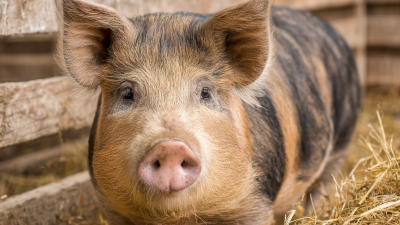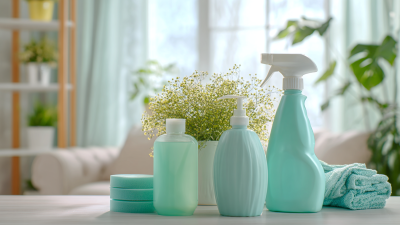In the pursuit of maintaining a vibrant and healthy aquatic ecosystem, pond enthusiasts often overlook the vital role of effective pond disinfectants. According to Dr. Emily Carter, a leading expert in aquatic health management, "The right pond disinfectant not only ensures water clarity but also promotes the overall well-being of aquatic life." The importance of selecting appropriate disinfectants cannot be understated, as they play a crucial role in controlling harmful pathogens and preventing disease outbreaks in ponds.

As we delve into the science behind pond disinfectants, it becomes evident that understanding their formulation and application is essential for any pond owner. A well-chosen disinfectant can lead to a balanced environment, supporting the intricate web of life that thrives below the surface. By examining the various types of disinfectants available and their mechanisms of action, we can unveil the secrets to creating a safe and enjoyable aquatic habitat.
In this article, we aim to shed light on the significance of using high-quality pond disinfectants and how they contribute to environmental stewardship. We will discuss criteria for selecting the most effective products, backed by scientific principles and expert opinions, ensuring that your pond remains a healthy sanctuary for all its inhabitants.
Pond ecosystems play a crucial role in maintaining biodiversity and supporting various forms of life. However, these ecosystems are increasingly threatened by pollution, eutrophication, and climate change. Effective pond management requires a deep understanding of water quality, which is essential for healthy aquatic habitats. Recent studies highlight that human activities are shifting the health and functioning of freshwater ecosystems, leading to alarming levels of nutrient pollution and degradation (Water.Europe). Regular monitoring of water quality is vital in aquaculture systems to prevent adverse impacts on natural water bodies, underscoring the interconnectedness of aquatic environments.
Tips: To ensure a healthy pond ecosystem, consider implementing a regular monitoring schedule for water parameters like pH, dissolved oxygen, and nutrient levels. Additionally, establish a buffer zone with native plants around your pond, which can aid in filtering pollutants and providing habitat for wildlife.
Furthermore, the significance of clean water extends beyond aesthetics; it is integral to sustainable development. Healthy ponds contribute to ecosystem services such as flood control, water purification, and recreation. Protecting these water bodies is essential for preserving biodiversity and enhancing community resilience against environmental changes. Investing in actions such as reducing runoff and managing invasive species can significantly improve water quality and ensure the longevity of pond ecosystems.
Ponds often serve as vital ecosystems, providing habitats for various aquatic life forms. However, they can become contaminated by several common pollutants, which pose significant risks to these organisms. Nutrient runoff, primarily from agricultural fertilizers, introduces excess nitrogen and phosphorus into pond waters. This nutrient overload can lead to algal blooms, which deplete oxygen levels and create dead zones where fish and other aquatic species struggle to survive.
Additionally, pathogens and harmful bacteria can infiltrate ponds through runoff from livestock or faulty septic systems, threatening the health of fish and amphibians. Heavy metals from industrial discharges and urban runoff also accumulate in pond sediments, posing toxic risks to both aquatic inhabitants and the birds and mammals that rely on ponds for food. Understanding these contaminants is crucial for implementing effective pond management strategies to preserve aquatic life and maintain healthy ecosystems.
Maintaining the health of a pond is crucial for the wellbeing of its aquatic life, and disinfectants play a vital role in this process. These chemical agents help control pathogens and algae, ensuring a balanced ecosystem. According to a recent industry report by the Environmental Protection Agency, proper pond management can reduce harmful bacteria by up to 90% when effective disinfectants are used. This is particularly important in biosecurity measures for recreational and ornamental ponds, where disease outbreaks can devastate fish populations.
When choosing disinfectants, it’s essential to select products that are safe for aquatic environments. Commonly used disinfectants include copper sulfate and sodium hypochlorite, but they must be applied with caution to avoid harming beneficial microorganisms. Regular testing of water quality is also necessary to determine the appropriate timing and amounts for treatment.
**Tips:** Always follow manufacturer instructions closely when applying disinfectants to avoid overdosing. Additionally, consider integrating natural alternatives like barley straw, which not only helps control algae growth but also promotes a healthier aquatic ecosystem without the risks associated with synthetic chemicals. Regular maintenance and monitoring of water parameters can go a long way in sustaining a thriving pond environment.
This chart illustrates the effectiveness ratings of various pond disinfectants, showing how each option ranks on a scale from 0 to 100. Proper selection of disinfectants is crucial for maintaining a healthy pond ecosystem.
When it comes to maintaining a healthy pond ecosystem, choosing the right disinfectant is crucial. Various types of pond disinfectants are available, each with their own set of pros and cons.
Chemical disinfectants like potassium permanganate and sodium hypochlorite are popular due to their efficacy in eliminating harmful pathogens and algae. Studies indicate that potassium permanganate can reduce coliform bacteria levels by up to 99%, making it a potent choice for water quality management. However, these chemical options may pose risks to aquatic life if not used correctly, raising concerns about their long-term environmental impact.
On the other hand, natural disinfectants, such as beneficial bacteria and enzymes, offer a less harmful alternative.
These products work by outcompeting harmful microbes, thus reducing their populations without disrupting the pond's ecological balance. Reports from the Pond and Lake Management Association (PALMA) suggest that ponds treated with these natural agents show a 50% reduction in harmful algae blooms over a season. Nonetheless, their slower action compared to chemical disinfectants may require a more hands-on approach to effectiveness monitoring. As pond owners weigh their options, understanding the benefits and limitations of each disinfectant type is essential for fostering a thriving aquatic environment.
When maintaining a healthy pond, the responsible application of disinfectants is crucial for ensuring both water quality and the wellbeing of aquatic life. Effective pond disinfectants, particularly chlorine, have been shown to eliminate harmful pathogens while allowing beneficial microorganisms to thrive. According to industry reports, the integration of chlorine in aquaculture not only improves biosecurity but also promotes the regrowth of natural food sources when timed correctly—ideally fertilizing the pond a few days after application to kickstart this process.
**Tips for Safe Application of Pond Disinfectants:**
1. Always measure the appropriate dosage of disinfectant according to pond size and water conditions to prevent toxicity to fish and plants.
2. Monitor water parameters closely before and after application—this includes pH, ammonia, and nitrite levels—to assess the impact of the disinfectant.
3. Introduce natural food organisms, such as phytoplankton, shortly after fertilization for optimal ecological balance before introducing larger aquatic species.
In a wider context, the global aquaculture industry faces threats like the shrimp crisis exacerbated by virulent pathogens. Implementing effective biosecurity measures, including the prudent use of disinfectants in pond management, is integral to safeguarding food supplies and maintaining a sustainable seafood environment.
| Disinfectant Type | Active Ingredient | Recommended Dosage (per 1000 gallons) | Application Frequency | Safety Precautions |
|---|---|---|---|---|
| Bleach (Sodium Hypochlorite) | Sodium Hypochlorite | 1-2 cups | Monthly | Wear gloves; avoid direct contact with fish. |
| Hydrogen Peroxide | Hydrogen Peroxide (H2O2) | 2-4 cups | Every 2 weeks | Use in well-ventilated areas; handle with care. |
| Copper Sulfate | Copper (II) Sulfate | 1-3 pounds | Seasonally as needed | Do not exceed recommended dosage; harmful to aquatic life. |
| Quaternary Ammonium Compounds | Cationic Surfactants | 2-5 cups | Every 3 weeks | Avoid contact with skin; keep out of reach of children. |






